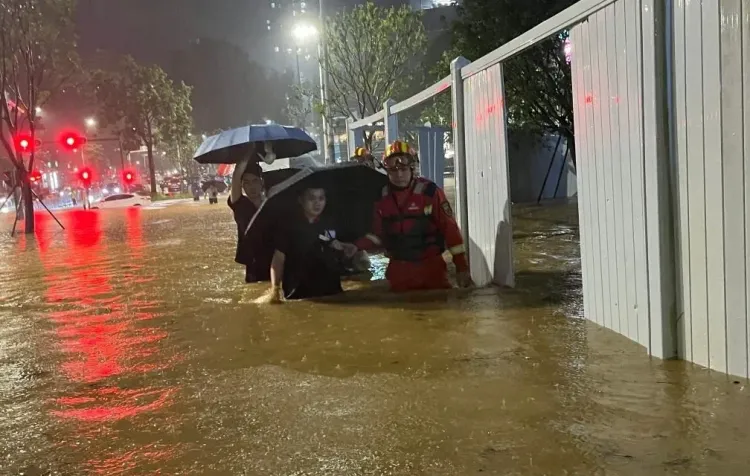Why Did Northeast China's Heilongjiang Issue a Red Alert for Rainstorms?

Synopsis
Key Takeaways
- Red alert issued for rainstorms in Heilongjiang Province.
- Forecast indicates up to 100 mm of rain in three hours.
- Emergency measures include evacuations and flood defenses.
- Severe thunderstorms and winds expected.
- Importance of preparedness underlined by authorities.
Harbin, July 25 (NationPress) - On Friday, Northeast China's Heilongjiang Province declared a red alert for rainstorms.
As per the Heilongjiang Meteorological Observatory, certain southern areas in the Mongolian Autonomous County of Dorbod are poised to experience an astonishing 100 mm of precipitation within a mere three hours.
At 5:50 a.m. on Friday, the provincial meteorological observatory released a forecast indicating imminent heavy rainfall in the main urban area of Harbin and nearby cities including Zhaodong, Wuchang, and Shangzhi. This is expected to occur within six hours of the alert.
Thunderstorms accompanied by strong winds are also anticipated in various regions, with gusts potentially reaching a force of level 7 to 8.
Local weather officials have urged all pertinent departments to activate emergency flood prevention and disaster response protocols, including the swift evacuation of individuals from high-risk zones, as reported by Xinhua news agency.
Measures to fortify defenses against urban flooding, river overflows, and mountain torrents must be enhanced, including rigorous inspections and reinforcement of bridges, culverts, roadbeds, embankments, and reservoirs.
China employs a four-tier weather warning system, where red signifies the most critical alert, followed by orange, yellow, and blue.
Previously, on July 23, China's national observatory had issued a yellow alert for rainstorms, cautioning about potential downpours in several regions nationwide.
On July 24, numerous areas across northern China initiated flood emergency protocols in anticipation of heavy rainfall.
The municipal government of Beijing escalated its rainstorm alert to yellow, the third highest level, and activated citywide flood-control emergency measures.
Moreover, the Haihe River flood control and drought relief headquarters, along with the river administration in the neighboring Tianjin Municipality, simultaneously engaged Level IV emergency responses for flood control and prevention at 3 p.m., bracing for moderate to heavy rainfall that could elevate water levels in main rivers and tributaries.










